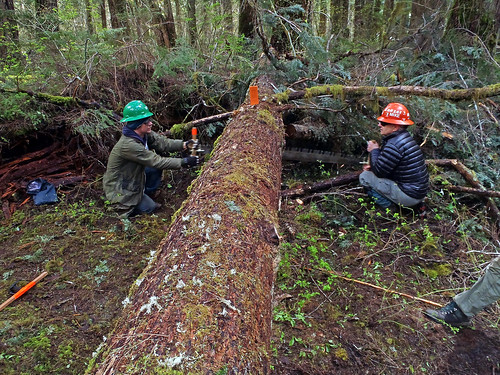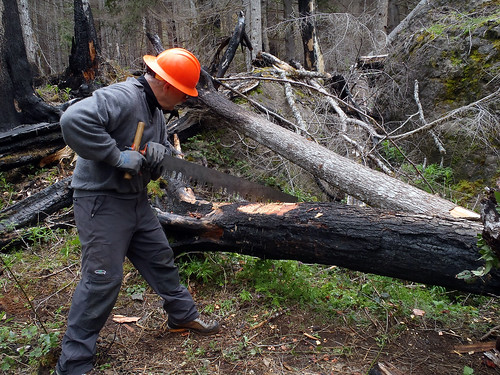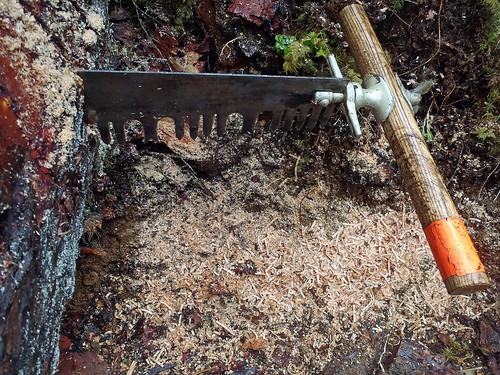
The daunting task of removing a fallen tree on the Olympic National Forest is best tackled with a partner. Two Washington Trails Association members work together using a cross-cut saw, which takes special training and a fine touch. (Courtesy Meg MacKenzie/Washington Trails Association)
The crosscut saw, once a symbol for conquering the wild forests of the west in order to provide lumber for America’s cities, now endures as a symbol of wilderness preservation in our national forests.
The crosscut saw reached prominence in the United States between 1880 and 1930, but quickly became obsolete when power saws started being mass produced. The passage of the Wilderness Act in 1964 has helped restore the dying art of primitive tool use by effectively requiring their use in wilderness trail maintenance.
In order to protect the wilderness character of our special places, the Wilderness Act limits the types of activities that are permitted within designated wilderness areas. With few exceptions, mechanical transport and motorized equipment are two categories of use that were deemed contrary to the nature of wilderness under the act. Such restrictions create unique challenges for managers and volunteers charged with maintaining wilderness trails, who must rely on primitive skills in order to accomplish their goals. All heavy equipment must be hauled in by hand or packed in using stock, all log bridges must be set in place with sheer strength or human-powered rigging, and all log cutting must be performed without the aid of power saws, typically using a crosscut saw.
In contrast to the cacophony produced by a chainsaw, a well-tuned crosscut saw operated by experienced sawyers creates a harmony that is more attuned to a wilderness setting. The sound a crosscut saw produces when slicing through a piece of timber is akin to a metallic hum, which is why crosscut saws are often referred to as the “saws that sing.” This is no accident, and depends just as much on a well-maintained saw as it does on the training of the sawyers who operate it.

A volunteer with the Washington Trails Association uses a cross-cut saw to clear fallen timber from a trail on the Olympic National Forest in Washington State. Volunteers use the saws even though their use is not required outside of a wilderness area. However, the association sees any use of the saws as an opportunity for training. (Courtesy Meg MacKenzie/Washington Trails Association)
Unlike chainsaws that require ear protection during use, crosscut saws allow sawyers the ability to communicate while sawing to ensure the saw runs smoothly. Good communication and planning, combined with a properly tuned saw, work in concert to create a clean cut. And when it’s really running smoothly the blade sings against the grain.
Saw sharpening and maintenance is an art – so specialized that only a handful of individuals exist on the Olympic Peninsula that are capable of properly tuning the old saws that keep Wilderness trails open and safe for all users.
One such individual, Tom Mix, a volunteer with the Backcountry Horsemen, trains and certifies sawyers including Forest Service employees. He is also one of those few skilled tuners, keeping alive the practice that is a vital aspect of maintaining these 4- to 10-foot saws.
The type of material that the original crosscut saws were made of—high carbon tempered steel—is no longer manufactured. This makes it even more important to maintain the old saws that still exist.
“It’s a lost art,” Mix says.
But he is doing his best to train others in the venerable art of crosscut saw use and maintenance, a primitive craft that continues to reverberate within the boundaries of your Olympic National Forest Wilderness areas.
This wilderness protects our special wild places and it protects a piece of our cultural heritage, those skills that frontiersmen and women used to shape their home on this wild peninsula. And it protects an old voice, the one that sings of history and hard labor in these woods.
The local group of saw filers is so exclusive that Mix says, “I can look at a saw and tell who filed it.”

This crosscut saw has a lance tooth pattern, which for years was the standard for felling and bucking timber in the American West. The lance tooth pattern is best suited for cutting soft green timber, especially fire, spruce and redwood. Crosscut saws vary in size, style and shape and are used in lieu of a power saw, which are prohibited in wilderness areas. All saws, regardless of the tooth pattern, are made up of two rows of cutting edges. The saw releases wood fibers on each side of the cut as it passes through a log. (Courtesy Meg MacKenzie/Washington Trails Association)
No comments:
Post a Comment